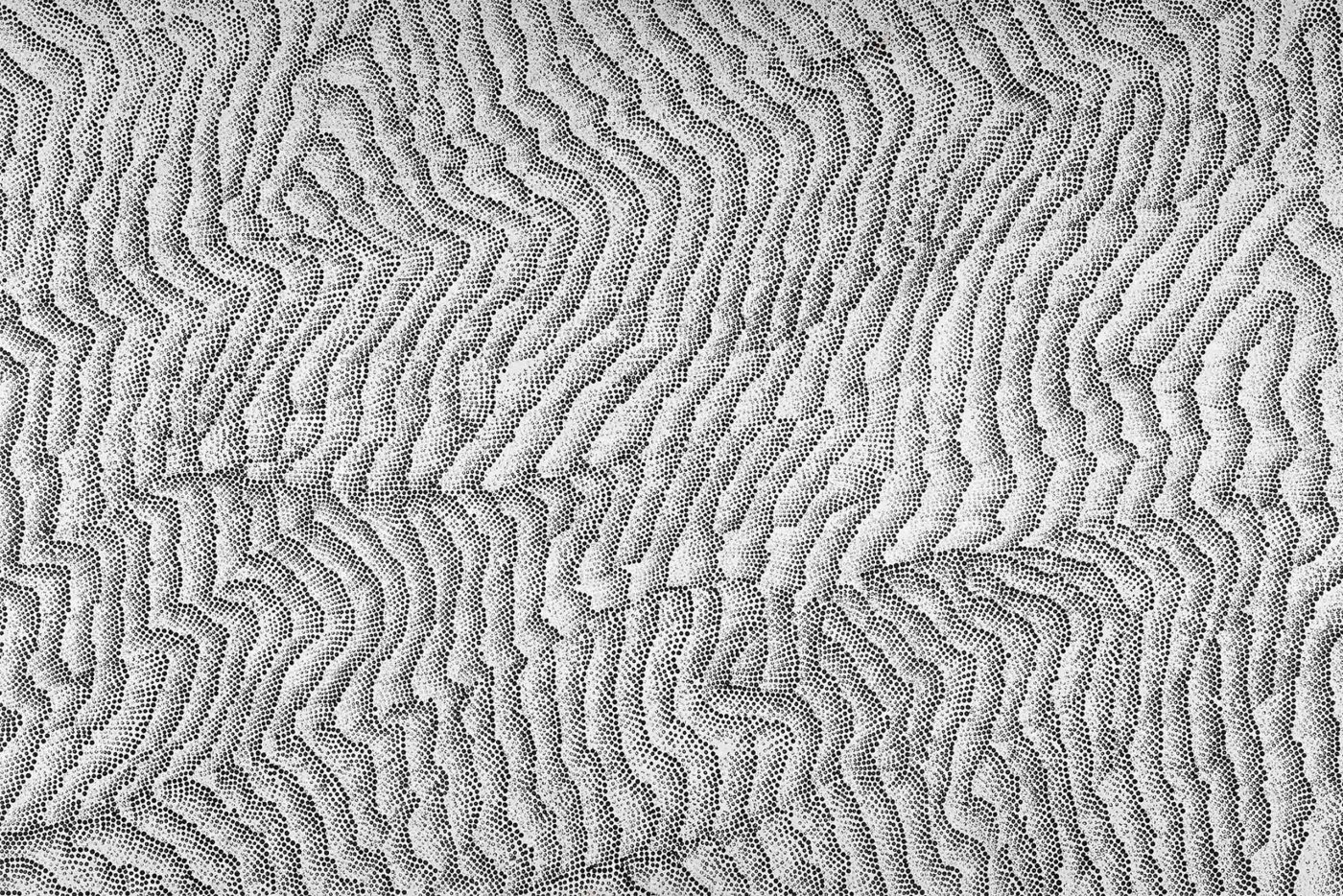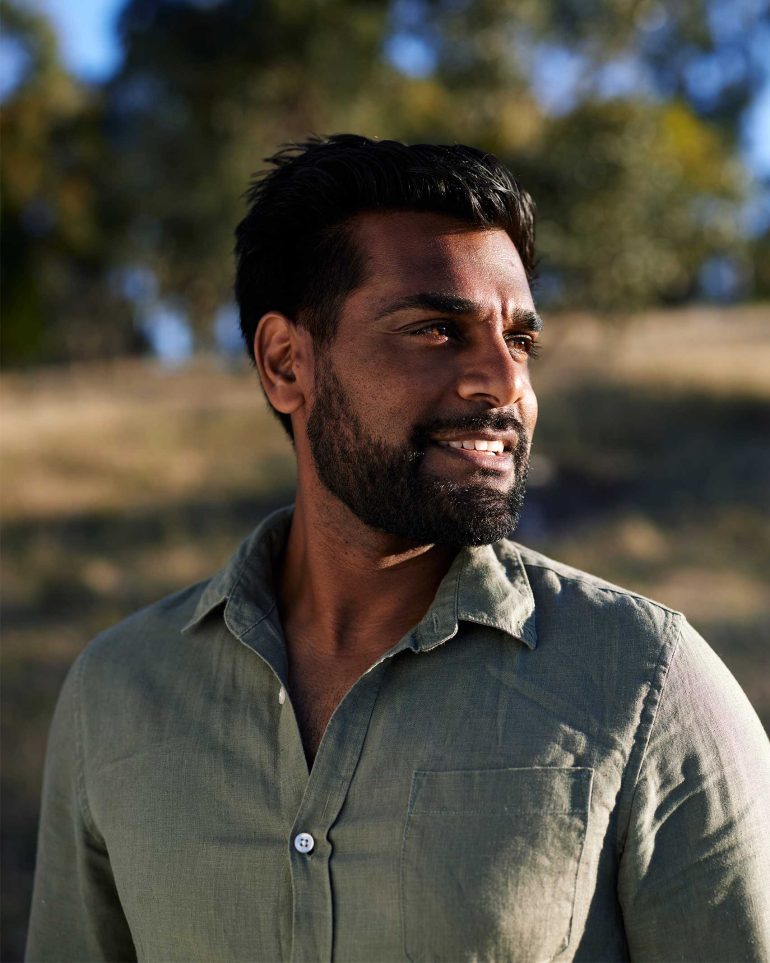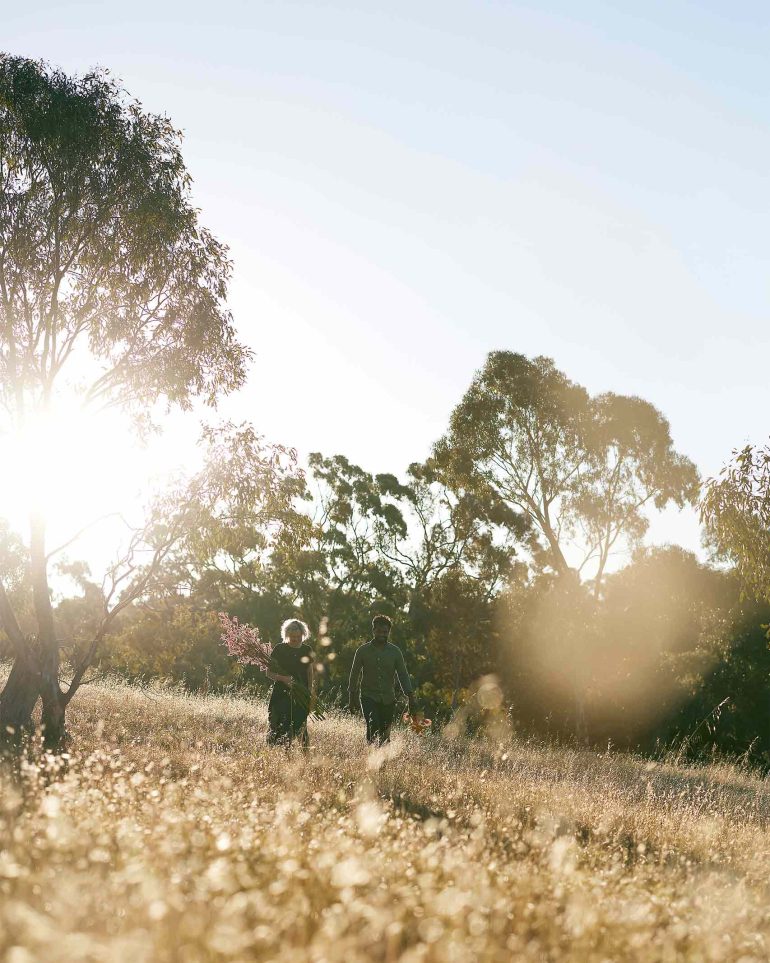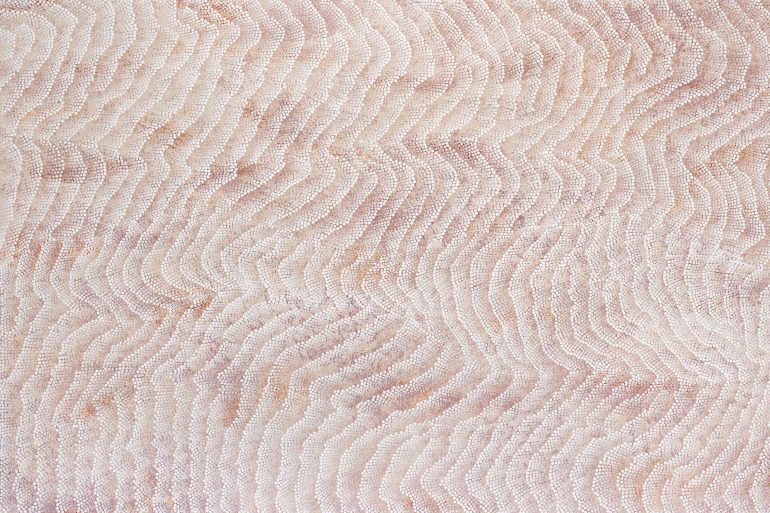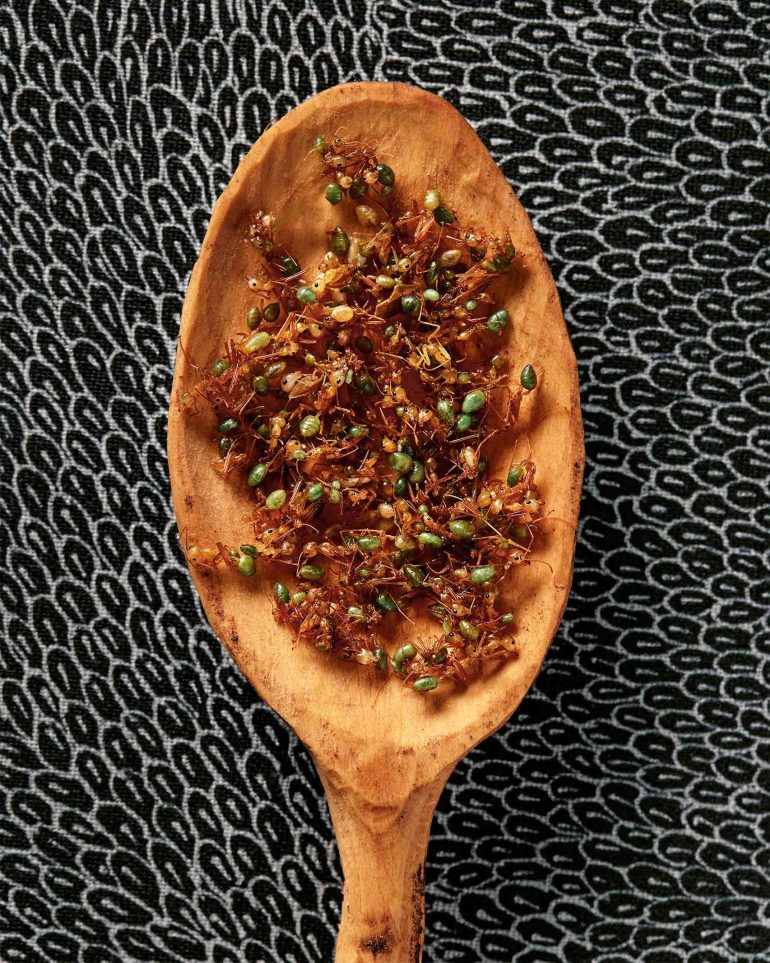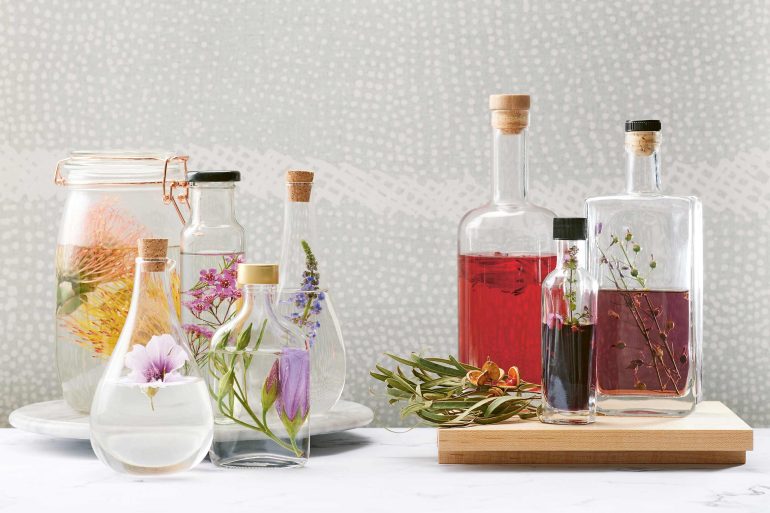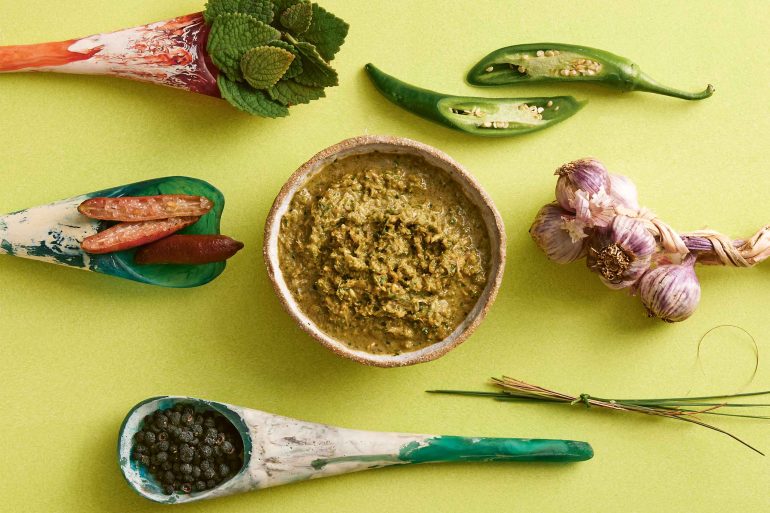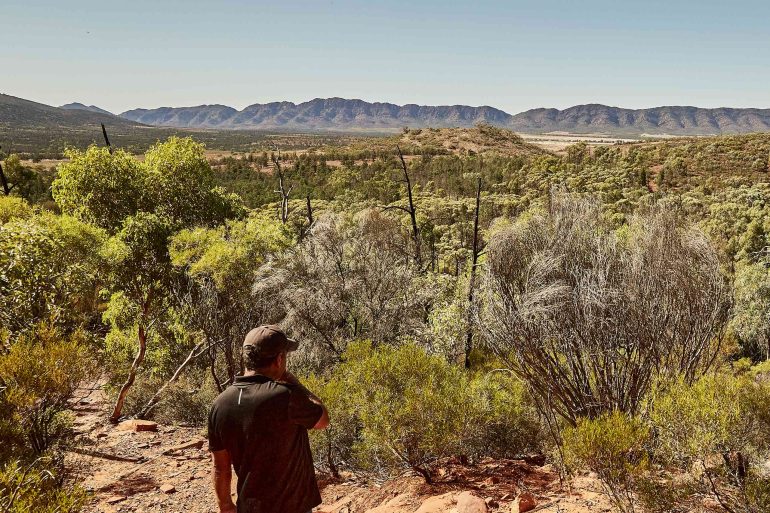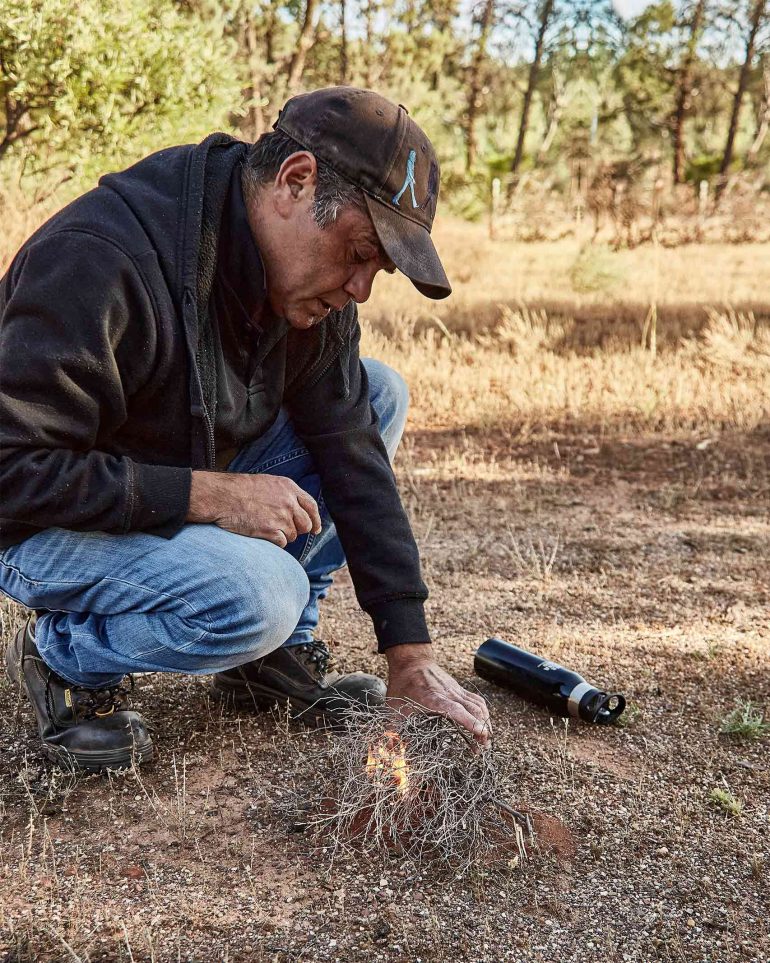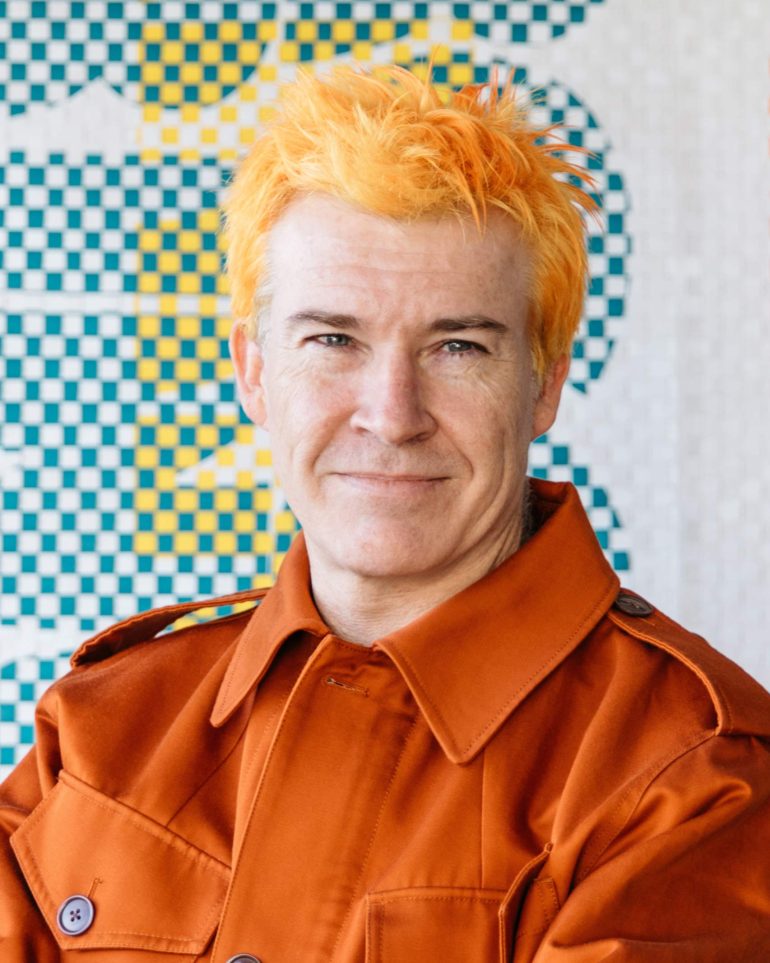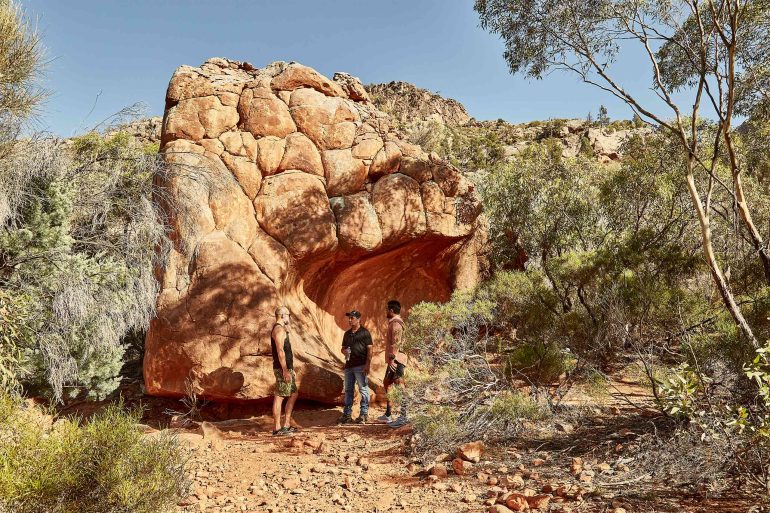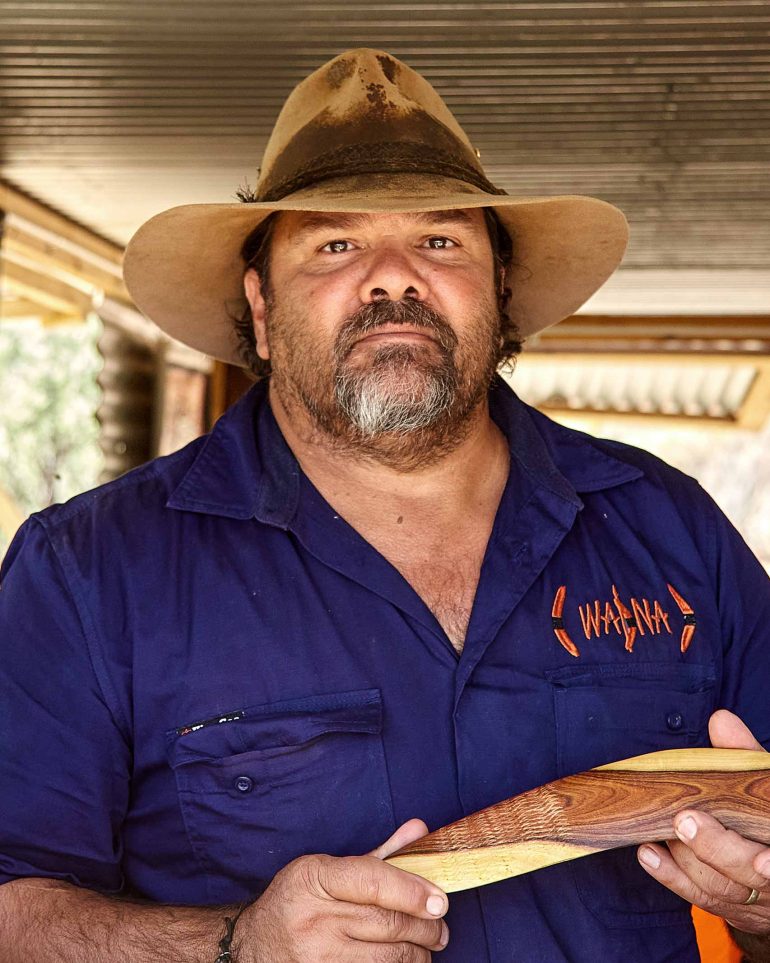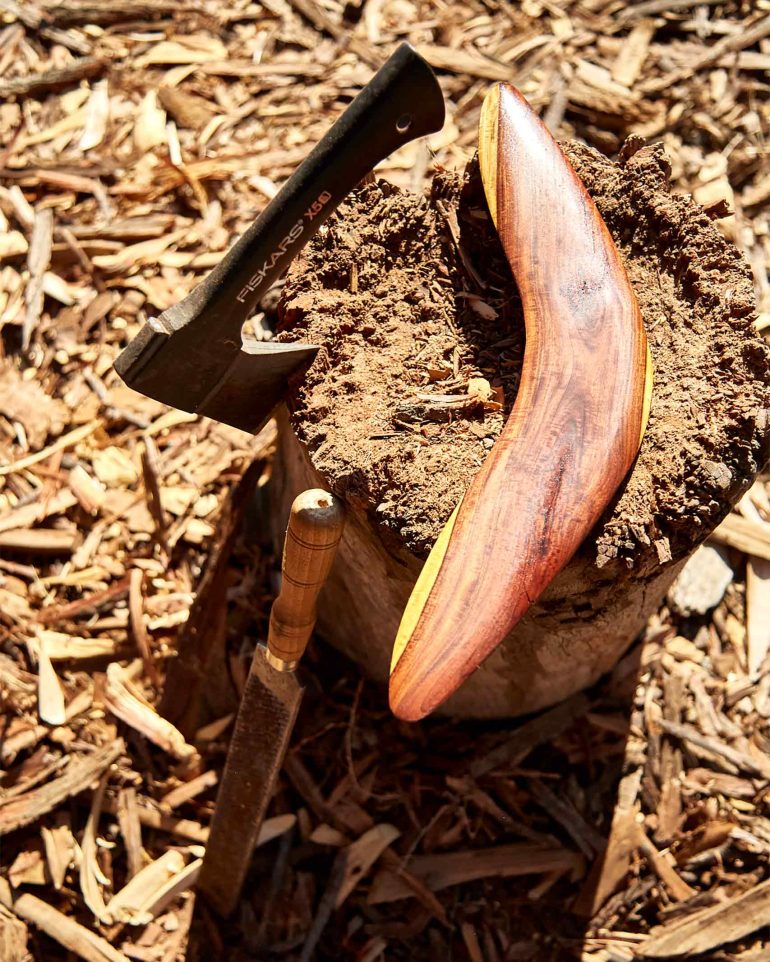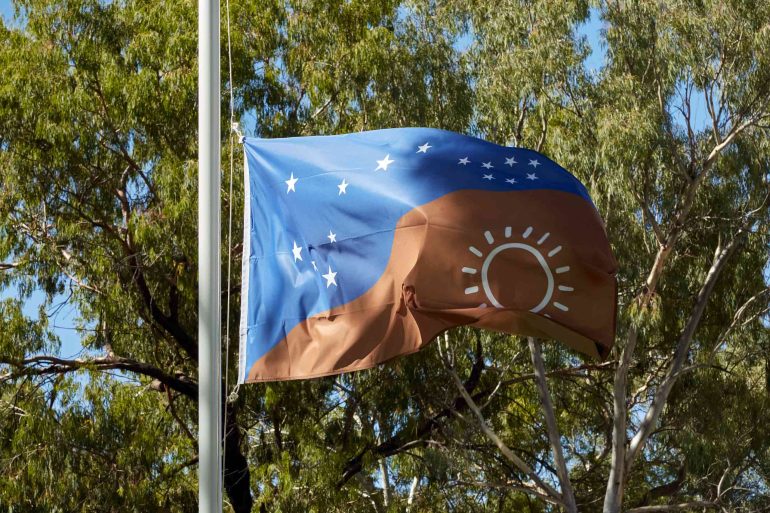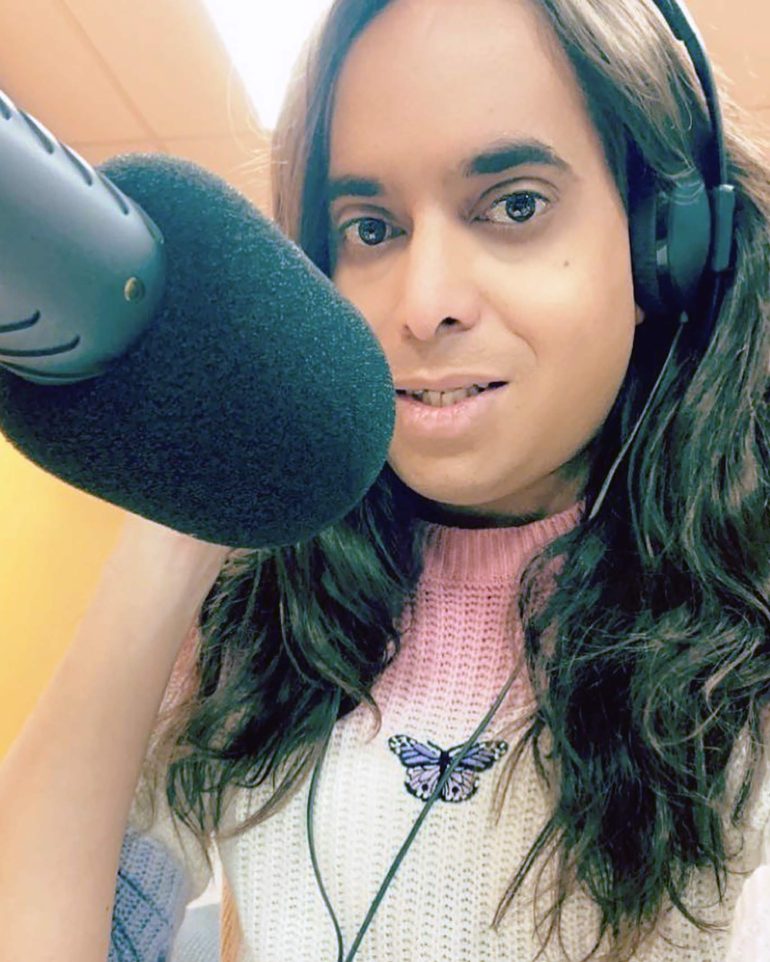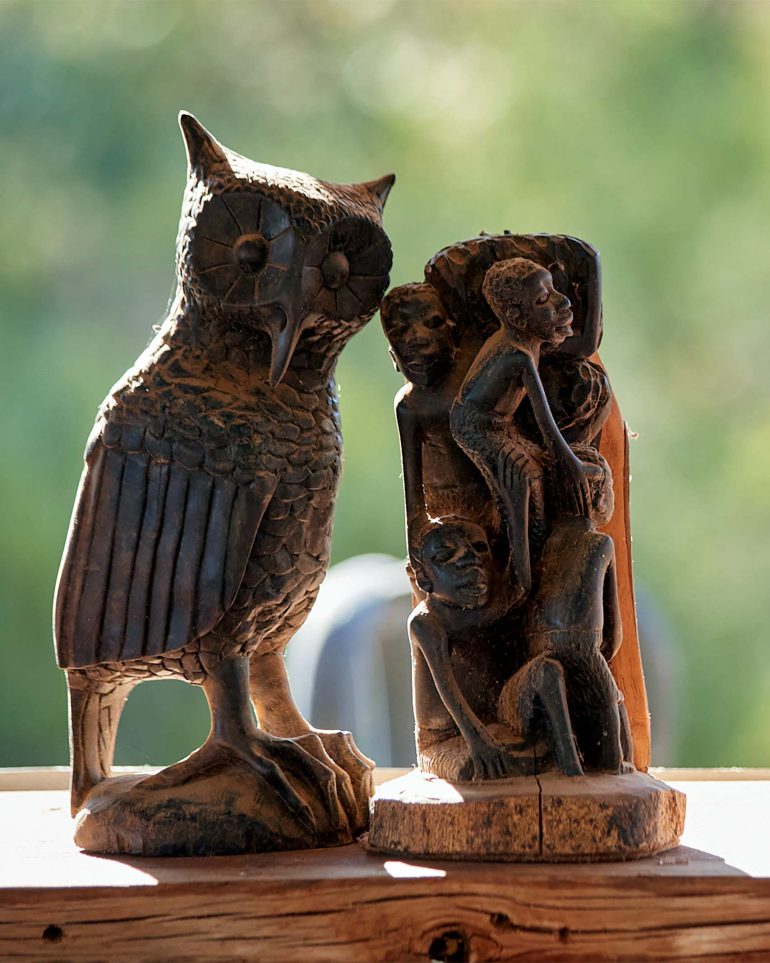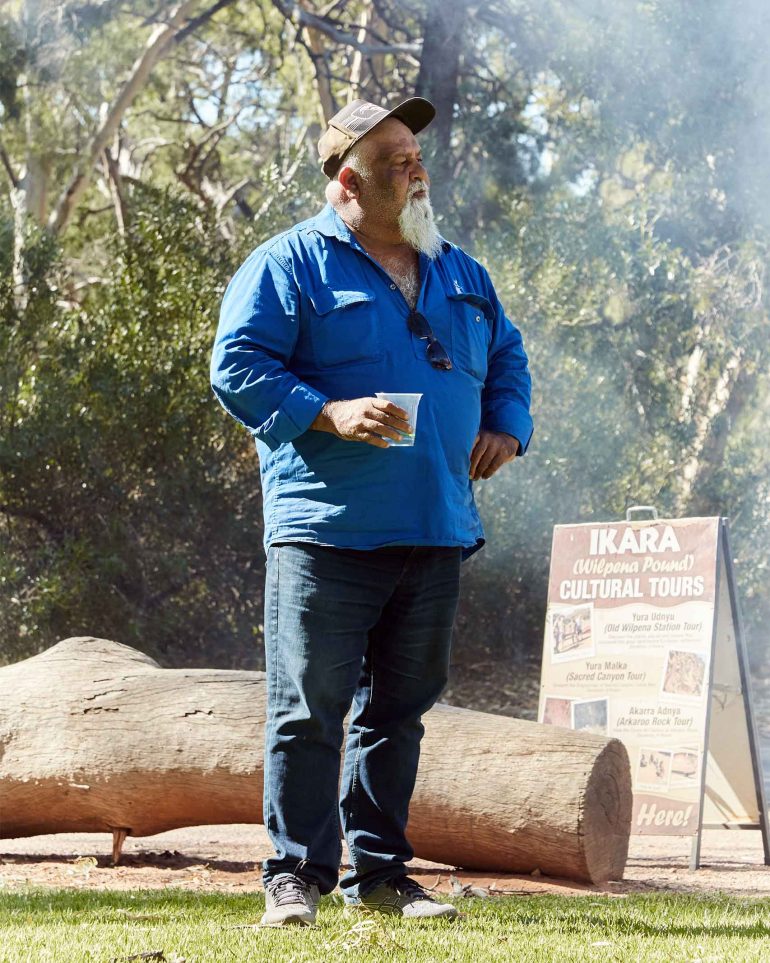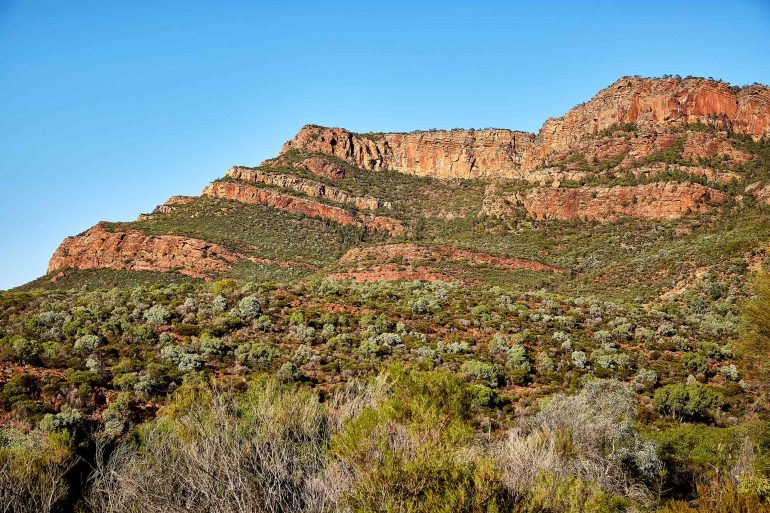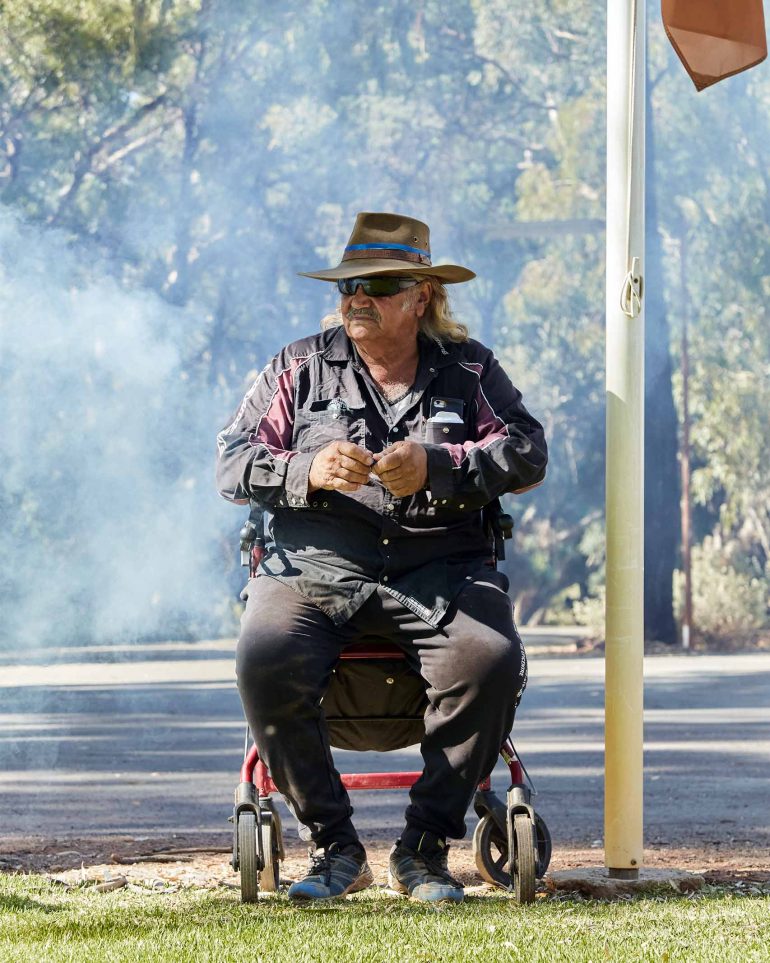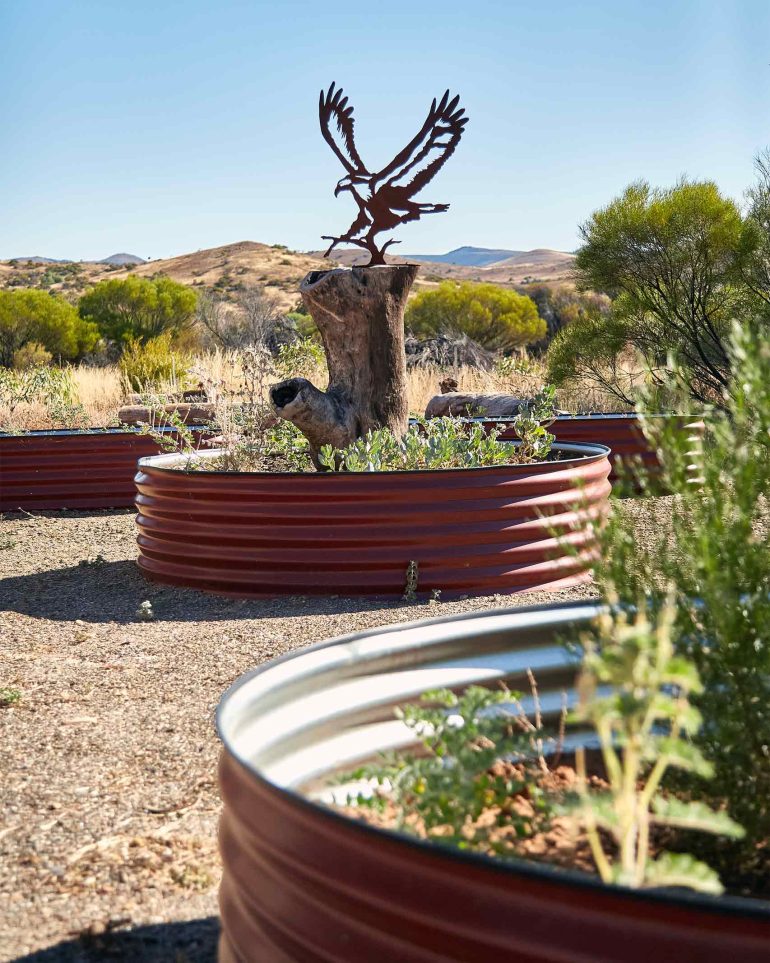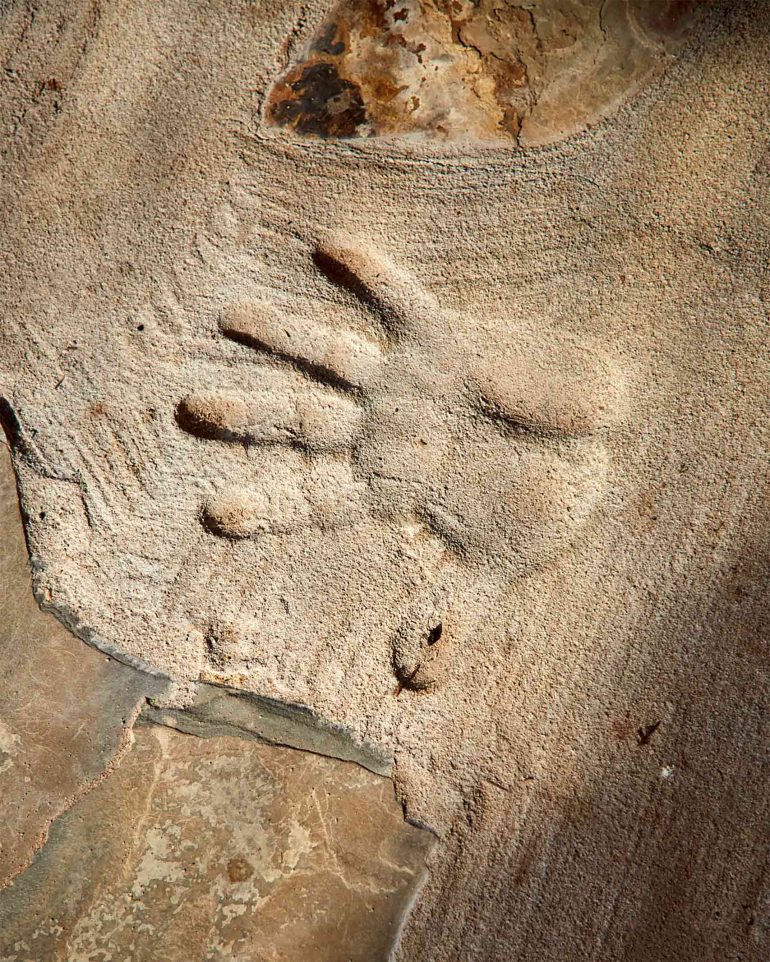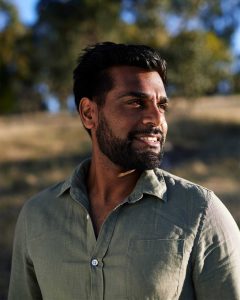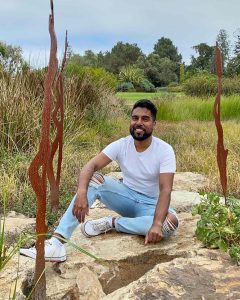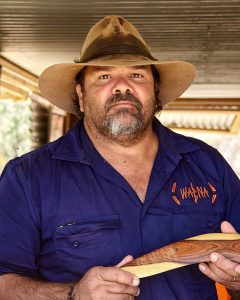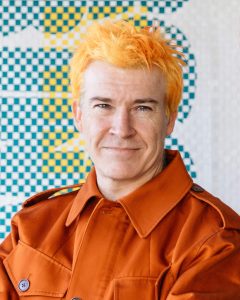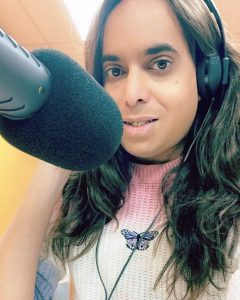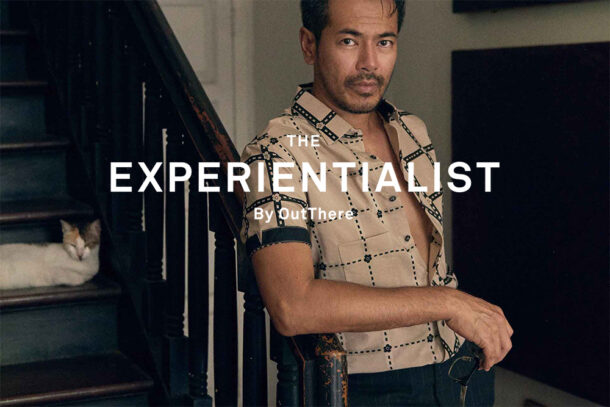Down Under may have far to go to repair the damage colonial occupation wreaked on Aboriginal Australians, but efforts to do so today are tangible. OutThere meets a remarkable First Nations family – and two queer trailblazers in the arts – each in different ways making a better collective future their mission.
The educator: Damien Coulthard
The feisty South Australian midsummer sun is at its zenith as my 4WD turns off the road 140km north of Adelaide and rolls up to the off-grid Clare Valley house of Damien Coulthard and Rebecca Sullivan. On a patio beneath a grapevine-trailing pergola, a table groans with a prismatic array of dishes, sauces, herbs and seasonings presented on artfully mismatched crockery. “Feast!” says Rebecca, her eight-month-old son Ngairri on her hip.
Rebecca has prepared this beautiful spread, whose dishes range from the familiar – roast chicken, char-grilled peppers, a cheeseboard – to the exotic – kingfish ceviche with finger lime and macadamia oil, deep-red wattleseed balsamic quandongs, green ant butter – to introduce me to the work of Warndu, a native foods brand she and Damien founded in 2016. Meaning ‘good’ in Damien’s ancestral Adnyamathanha language, Warndu is, she says, “kind of a food brand in disguise. Our bigger mission is cultural reconciliation, environmental awareness and empowering First Nations communities.”
Warndu is just one of many ways Damien has dedicated himself to uplifting people, like him, of Aboriginal descent. A schoolteacher of among other things Indigenous studies for 15 years, he has mentored countless students from many of the 350-plus Aboriginal Nations this vast country encompasses to discover and purposefully connect with their heritage, a rite denied generations of First Nations people by colonial occupation.
“Growing up I was lucky to have strong role models in my family who are deeply proud of our culture and maintain our connections with it. We would visit my parents on Adnyamathanha Country in the Flinders Ranges, and they would tell me our people’s traditional stories around a campfire out in nature. It gave me a strong sense of belonging and my own potential. A lot of young Aboriginal people don’t have that, and I want to fulfil that role for them. A sense of identity and cultural belonging is so important to their life choices, in a society still rife with discrimination and inequalities.”
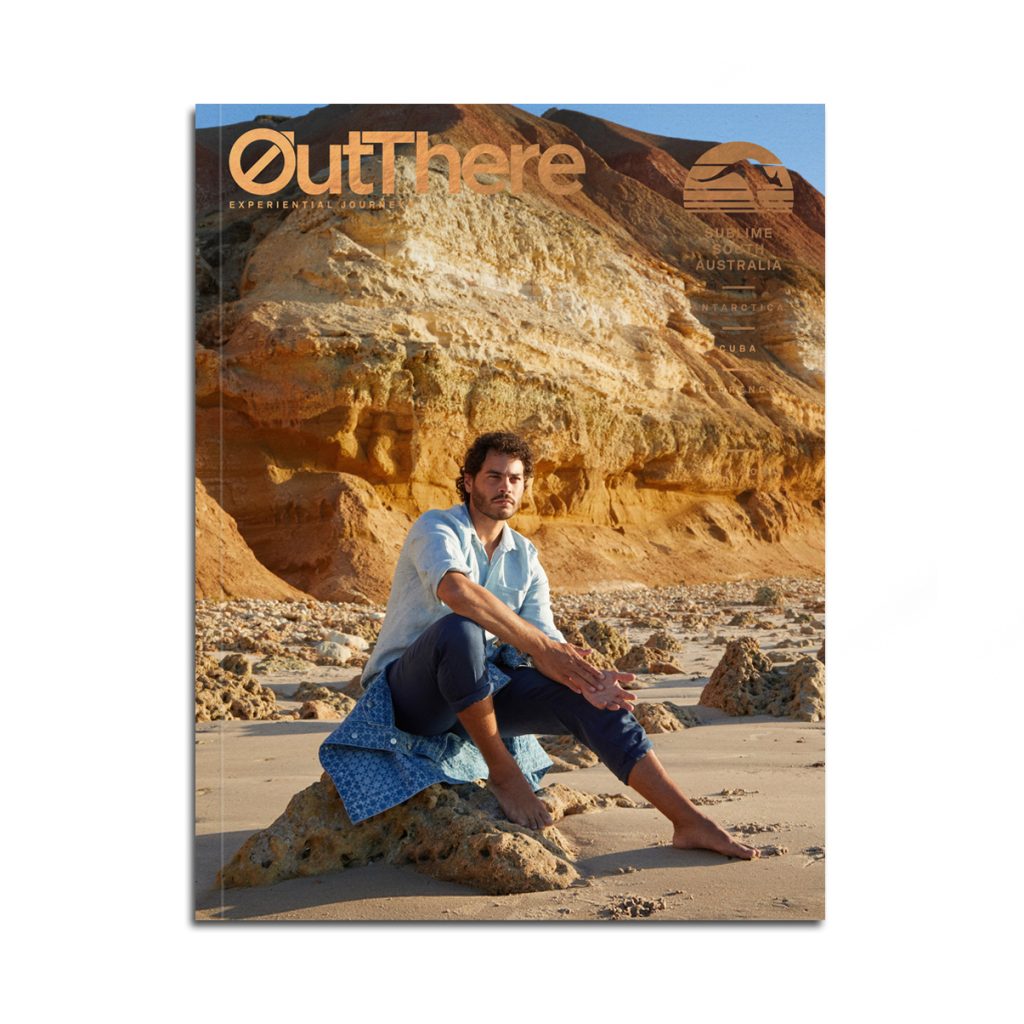
This story first appeared in The Sublime South Australia Issue, available in print and digital.
Subscribe today or purchase a back copy via our online shop.
Mainstream efforts towards reconciliation of modern, westernised Australia with the Land’s Traditional Owners, whose numbers were decimated over 100 years of colonial settlement from an estimated million to just 60,000, seem more tangible today than ever. Political milestones have included a 1967 referendum that at last recognised Aboriginal people as Australian citizens, the launch by Australia’s parliament in 1991 of the Council for Aboriginal Reconciliation, and a 2008 speech of apology by then prime minister Kevin Rudd to Aboriginal and Torres Strait Islander peoples, especially to the ‘Stolen Generations’, at least 100,000 children forcibly removed from their parents under the government’s ‘Assimilation’ policy. And in daily life, ‘Acknowledgements of Country’ – words of recognition of places’ ownership by the respective Aboriginal peoples native to them – can be heard or read everywhere.
‘But we always fall short,’ says Damien, ‘and have done for far too long. Life expectancy remains far lower and job prospects far worse for most Aboriginal people. We account for three per cent of the population, but a quarter of the prison population. Indigenous studies is, since very recently, a growing field, but it’s still optional for schools, and how can we move forward as a united country if we don’t at least have all students learning about Aboriginal Australia and the truth of colonial occupation?’
In his role at Warndu as cultural educator through events and outreach programmes, Damien doesn’t shy away from the brutalities of Australia’s history, but keeps his focus on empowering Aboriginal and non Indigenous people alike to work together towards positive outcomes – “because it’s about uplifting all of us”. He’s happy to note that Warndu has so far brought business and profile to many First Nations-owned growers, harvesters and producers including Pundi Produce in South Australia’s Riverland region, Alice Springs’ Kungkas Can Cook and Melbourne Bushfood. Beyond that, his education work has given teachers without expertise in Aboriginal cultures the materials and confidence to spread the word to their students and colleagues.
He and Rebecca have plans too for the 86 acres of forested, hillside farmland surrounding their house which they bought five years ago. Jumping in the car with Mallee, at three the older of his and Rebecca’s two sons, Damien takes me on an off-road tour, and shows me a run-down stone outbuilding close to the property’s entrance, and at the top of the hill a shed with commanding views – mind-blowing at sunset, he says – across endless flat farmland towards the Spencer Gulf. They will convert these two sites – plus a secluded glamping spot among trees – into “three architect-designed eco accommodations where guests can come and really immerse in the environment. We’ll invite Elders from the Ngadjuri community whose land this is to conduct a ‘Welcome to Country’ ceremony and share some of their people’s ancient stories, give guests opportunities to taste or cook with native foods from our garden, share the land with roaming deer and kangaroos, and just feel connected to place – between visits to Clare Valley’s amazing wineries and restaurants, or whatever they feel like doing.”
The architect: Azhrudin Coulthard
The architect in question is Damien’s brother Azhrudin, who works for GHD in Adelaide, and who I later talk to in the city. Also a trailblazer, Azhrudin, an out gay man, is one of very few First Nations people with a successful career in a high-profile global architectural practice. “In my first year of training, I was the only Indigenous person in my whole cohort, and there were just two others I knew of in all South Australia. I’m discovering now though that there is a strong indigenous network in architecture, which feels really significant, and new. I’m conscious I might be a role model for other people, who perhaps didn’t have the example of supportiveness and drive and pride in who you are I had from my family, and I hope I can be that. Similarly as an Indigenous LGBTQ+ man, I hope by being visible I can contribute to easing in other people the fears I had about the stigma that still clings to being gay, especially outside the city, and within Indigenous cultures, where it’s not really talked about. Life really can get better, and it’s important to focus on the positives to move forward.”
Even just a few years into his career, Azhrudin is vocal at work about the value his connection to his heritage and understanding of Aboriginal communities’ spiritual connection to Country can bring to architecture and landscape design, a perspective Damien and Rebecca want to spotlight with their new lodgings. “I envision these as structures that touch the land softly and draw in the surrounding vistas. To me architecture is about telling stories, as my grandparents told me stories when we visited them on Country that heighten how you experience your surroundings. I try to let this inform my work, and GHD have been very encouraging, also welcoming my input for their reconciliation action plan” (a formal document organisations draw up setting out how they will tackle inequalities based on nationhood).
Beyond Warndu, Damien continues to work as a teacher, while fulfilling multiple consultancy roles on governmental and academic projects around reconciliation and economic empowerment of First Nations businesses and communities. Somehow he also finds time to be an artist, and his paintings, inspired by Adnyamathanha creation stories told him by his grandparents, have been exhibited internationally. He shows me a large, softly mesmerising work on the wall of his house, explaining its representation of a creation story of Akurra, a gigantic serpent who created monumental features of the Flinders Ranges landscape where Damien harvested the ochre, a prized commodity to the Adnyamathanha and other Aboriginal peoples for tens of thousands of years, for his paints. ‘We’ll be there tomorrow, and do a tour with Uncle Mick. He’ll explain it to you much better than I can.’
As I learn the following day when Damien accompanies me, with Uncle Mick and local guide Ringo, to Flinders Ranges’ spectacular 800-million-year-old outback mountainscapes, it’s now more possible than ever for visitors to discover this country guided by the knowledge of those who know it best, as its custodians since prehistory. “Otherwise you’re just looking at a bunch of symbols,” says Ringo as he explains to me the significance of some 5,000-year-old cave paintings at Arkaroo Rock. “I’ve been taught by my community to understand the messages they tell. Although Aboriginal peoples had no written culture, until colonial missions, and then historians and anthropologists decided to record our languages and stories after the invasion, I’m proud to be part of a tradition that took great care to orally pass down stories that taught us how to live on country, and which have helped us be the oldest surviving culture on earth. And with so many Aboriginal languages already lost, I’m also really proud of my mum and dad, who spent over 40 years working on an Adnyamathanha dictionary, which was eventually released during the pandemic.”
The Flinders Ranges’ most iconic landmark, the imposing natural rock amphitheatre Wilpena Pound, is a happy example of successful reassertion of Aboriginal land rights. Relying as colonial settlers did on the principle of ‘terra nullius’ – that the land belonged to no one when Europeans first arrived – a mining company extracted uranium close to nearby Lake Frome. Successful challenges to this principle across Australia have since rejected it in favour of recognising local Aboriginal peoples’ native title to the land, and in this case the ensuing compensation enabled the majority acquisition of Wilpena Pound by First Nations people and its development as a largely Adnyamathanha-run visitor attraction. I see Ringo again at the ‘Welcome to Country’ performed at the destination’s eponymous resort later that day, and he explains the role of the traditional practice, which must be performed by a local community Elder, in interceding with the land’s ancestor spirits to ensure safe passage for visitors.
The craftsman: Kristian Coulthard
On our way back south the following day, we make a stop in the tiny former copper mining town Blinman to pay a visit to Damien’s second cousin Kristian Coulthard. A keen amateur craftsman since learning how to make wooden boomerangs, ceremonial shields and tools from his grandfather and great-grandfather as a child, Kristian, a former national park ranger and miner turned his skills into a new career during Covid’s world-halting first two years. Today, as well as guiding tour groups in the area and speaking to school groups about his heritage, he makes traditional wooden artefacts and sells other First Nations-produced goods in the simple workshop and shop he runs with his wife Gabrielle on the edge of town, called Wadna, the Adnyamathanha word for boomerang. Stocked with products from medicinal balms to herbal teas to sauces and preserves, the shop’s shelves are a mini-directory of independent First Nations brands bringing money into their respective communities.
With the (relatively) cooler tourist season just around the corner, Kristian’s busy building up stock, as well as preparing to start on a large-scale sculptural piece for University of South Australia’s prestigious Samstag Museum in Adelaide for exhibition next May. He tells me he’s seen an increase in people taking a genuine interest in Aboriginal cultures, and a positive shift in his lifetime in terms of respect for the nuanced wisdom of his ancestral culture.
“We embraced the white man’s laws and customs in the end, because they weren’t going to go away. We learned to read and write, we learned to be less nomadic and keep modern homes. Now they are adopting our ancient land-management and fire-management practices in national parks, because with climate change the issue it is, they see how scientific those practices are, how they came from a really connected understanding of Country. We weren’t wandering primitives, we lived in small communities that moved to a new spot periodically so the land we lived on could regenerate and stay able to sustain us.
“Things are changing now, for sure. Well-intentioned as they may be, I don’t love the new labels – First Nations, Indigenous, Traditional Owners. Aboriginal people don’t have that concept of ownership. To us that’s a colonialist attitude. We just belong. It’s a partnership. I’m not an owner because I can’t take Country with me, one day I’ll go back to Country. But I also agree with my grandfather when he used to say, ‘How are they supposed to learn if we’re not willing to teach?’”
Kristian refers too to the referendum due late this year on establishing as part of the Australian constitution an ‘Aboriginal and Torres Strait Islander Voice’ – of up to 24 First-Nations leaders from all over the country – in parliament. Strongly backed by Anthony Albanese, the Labor prime minister whose election last May ended nine years of stultifyingly conservative government, the referendum responds to 2017’s poignant Uluru Statement From The Heart, drafted by more than 250 Aboriginal and Torres Strait Islander delegates from all over Australia, which called for recognition of their communities’ spiritual sovereignty over the land, treaty making and truth-telling in the name of a new, integrated expression of modern Australia’s nationhood.
“It’s scientifically proven now that Aboriginal peoples have been here at least 50,000 years. Our people are ruled by a constitution that so far doesn’t recognise us. I think if we get a ‘yes’ vote, we can at last come together in harmony as a nation and just start getting on with business. Because we’re all custodians of this country. All of us.”
The artist: Troy-Anthony Baylis
Adelaide-based artist Troy-Anthony Baylis describes himself as Aboriginal-queer, and a collector, archivist, educator and KYLIEminologist, among other things. He is a descendant of the Northern Territory’s Jawoyn people, with Irish ancestry. Pop culture, art history, indigeneity and queer aesthetics are among the eclectic influences on his work, which explore themes of identity, colonialism and historical amnesia through media from paintings to embroidery to drag performances. His work has been exhibited widely across Australia, shown or performed in New Zealand, the Philippines, Iceland and Germany, and he has a new solo show from 20 June at QUT Art Museum in Brisbane.
In some ways I see my work as like permaculture in gardening. It sort of incorporates the pests and parasites – which for me can be negative stereotypes, painful elements of history – to make things stronger, more beautiful. For my Nomenclatures series of works l literally wove together German and Anglicised place names that denote the same place. Over the repurposed and reconstructed blind fabric I embroidered their Aboriginal names, to acknowledge and celebrate all three histories of each place at the same time – kind of typographic decolonisation.
There are some historical accounts of Aboriginal gender diversity and queerness, but not much. I’ve chosen to debunk the so-called evidence there was, because it was written by non-Aboriginal anthropologists, and turn that around to see the subject as a blank sheet, fertile ground to start creating First Nations queer culture now. I’ve made works refering to Mimis – creation spirits who can be seen in rock paintings dating back 50,000 years in the Northern Territory. They embody spirituality, creativity and gentleness, with some traits of the trickster. They are also genderless.
Nowadays I’m seen as a bit of an innovator in terms of queering Aboriginality in art. I’ve been working in this space for a while now and at times I felt like a loner in the wilderness, but there is something of a movement that has been coalescing. Karla Dickens is another well-recognised artist who works across overlapping themes, and r e a has been making queer Aboriginal work for much longer than we have. I was recently in Sydney for WorldPride and it was good to see quite a lot of queer First Nations work in the arts programme. Audiences seem to be embracing it. I think broader Aboriginal and queer audiences can relate to oppressions and the desire to be celebrated.
I lived in many places as a child, ending up for some years in Brisbane. I left home at 16 and moved into a place for vulnerable queer youth called Prospect House, and that became a little community for us to grow up together. It was a difficult time, near the end of the AIDS pandemic, and media messaging around gay people was not positive. But we would discover culture together in music and movies, and have parties, dress up super-creatively on a thrift-store budget. My school specialised in music, and I played instruments, composed and was going to be a musician. But at the last moment I wanted to embrace my own creativity, not play other people’s works, and I got into art school at Queensland University of Technology. I have a solo show there later this year and it feels like quite an emotional homecoming after so long.
And recently I was invited to co-design with another queer local artist Dylan Pimm the Pride Progress armband, worn by the captains of Adelaide United’s men’s and women’s teams to show support for the LGBTQ+ community. I saw it as an opportunity to try and turn around the terrible history many LGBTQ+ people have with sport from school days – and queer a traditional mainstream space.
The trans activist: Charlotte Coulthard-Dare
Born in “Tarndanya, aka Adelaide”, Charlotte Coulthard-Dare grew up in the Flinders Ranges before studying broadcasting and media at Batchelor Institute of Indigenous Tertiary Education in the Northern Territory. Today she presents Nunga Wangga, a weekly show spotlighting First Nations stories, talent and music on Adelaide Radio which is also rebroadcast on radio services in Sydney, Brisbane and Alice Springs. A committed activist, Charlotte regularly speaks publicly about her experience and is an important role model for Australia’s First Nations, queer and trans communities.
A box, in a box, in a box. That’s pretty much what my life is. I’ve experienced discrimination for being First Nations, for being queer, for being trans. Even for being quite light-skinned – people have said I’m not really a blackfella, or nunga, which is a friendly term indigenous people call each other. So I live my life inside all those boxes, like a Russian doll. I’m also a sistergirl, a term from the north for First Nations trans women, which is now being claimed with pride all over the country.
I’m proud too to be an Adnyamathanha, Barngarla and Yankunytjatjara woman. I grew up very supported by my family and very connected to my culture which I love, although both of my grandmothers were stolen as kids, part of the Stolen Generations, which is a sad part of my heritage. It’s so good to see today way more First Nations faces and content on TV and in advertising, and how well organisations like CAAMA and SBS’ National Indigenous Television service are doing.
I studied in Port Augusta, and came out as queer there when I was 16. I was the first openly queer person in town, and it makes me happy that many others have told me that helped them come out there too.
Then, nine years later, I had to come out again, as trans. I knew just one other trans person, when I was studying in Batchelor, so it was hard, but by then I understood that’s who I was, and all I’ve ever wanted is to live, respected and loved, as my true self. That’s also a big part of why I’m on radio, to share my experiences and connect other trans people to Australia’s trans and LGBTQ+ communities. My family have been amazing, and my dad, a prominent Barngarla Elder, is probably my biggest supporter. I came out to all but my closest family via a documentary I had made about my life in 2016 called Just Harry – and am in talks currently about making a part two.
Being so visible has its good days and its bad days. I’ve had my share of milk cartons thrown at me. But it’s also amazing to be recognised for making a difference. I was named the first LGBTQ+ Person of the Year at NAIDOC’s (National Aborigines and Islanders Day Observance Committee) annual awards, and was Ambassador for Feast festival, Adelaide’s three-week-long celebration of all things queer and beautiful, in 2021. And I’m just back from Sydney, where I was very proud to be asked to speak at WorldPride’s human rights conference about fairness in the justice system. And I loved doing a lingerie shoot, with 99 other women of all shapes and sizes, for an art photography project called Underneath We Are Women in 2016.
I reckon Adelaide is a great place to be queer. It can be a bit cliquey, but what queer place can’t? We really showcase our queer arts and culture, through Feast, Adelaide Fringe, South Australia’s History Festival. And there are some great spots to hang out. I love the club Mary’s Poppin, and I really love My Lover Cindi, it’s run by a beautiful lesbian couple who really respect their First Nations brothers and sisters – we get in free. And another really cute little place I love is Diverse-City, a hidden gem with beautiful food, great cocktails and live bands.
www.warndu.com | www.wadna.com.au | @btroyanthony | @coultharddare
Photography by Josh Geelen, Stirling Baird, Sia Duff, Martin Perry and courtesy of Charlotte Coulthard-Dare


